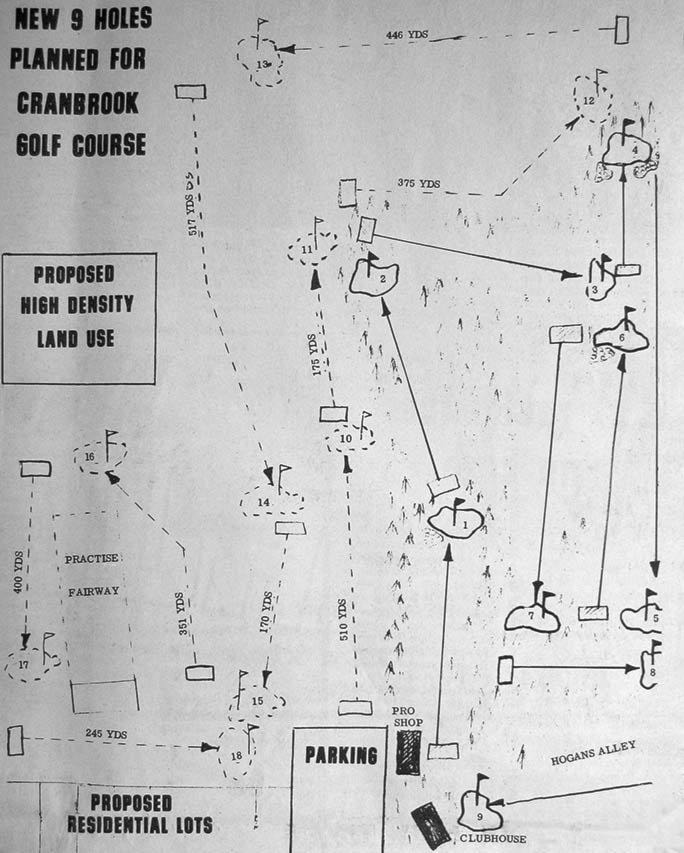Jim Cameron
In years to come it may well be that the present day will be regarded as the Golden Era of local golf. Certainly the sport has neve]r been more popular than now.
Still, there is always a vanguard, those who first set the ball to rolling, so to speak, and that honour indubitably rests with the Cranbrook Golf Club although they were not the first in town to form an association dedicated to the pleasures of the links. That occurred in 1904, when a small group formed the Kootenay Golf Club of Cranbrook and laid out a nine-hole course just to the east of what is now Slaterville. Although successful for a time they gradually faded from view.
In 1915, a meeting was held in city hall to elect the officers of the new Cranbrook Golf Club. It was comprised largely of local professionals: practitioners of medicine, law, real estate, business and merchant houses.
Nor was it just the men; from day one women also took an active part in the club both on and off the course. The old course was improved, a new clubhouse built and new members actively sought.
By 1920, the group decided to buy 111 acres of land from the Canadian Pacific Railway and move to a new location north of the city on Joseph's Prairie.
A new course, a new clubhouse and a new weekly golf column in the local newspapers featuring club notes and golfing tips did much to raise the profile of the sport. And the arrival of an honest-to-goodness golf pro in the spring of 1921 certainly picked up the pace, both technically and socially. Louis Anderson, son of a well-respected pro from Winnipeg, arrived in town in early April.
The young golfer, living and working out of a building on the course constructed for his use, spent his days improving the links, repairing golf clubs, selling golf accessories and giving lessons to members. The local paper remarked that "Louis sure know how to put the 'feel' in a club. It is not only Louis' smile and fair hair that makes a hit with the girls. One of them swears by him because he showed her how to hit 'em out with her mid iron which hadn't been working any too well."
He stayed for the season and although it would be some time before the club hired another pro, the bar had certainly been raised in terms of what the local club wished to accomplish.
The course itself was often described as "sporty", a term generally inferring somewhat less than ideal. There was also the additional problem of playing the first hole across the highway (what is now "the Strip"), not to mention the interruptions by various wildlife and an occasional grass fire but, all things considered, with the impressive Selkirk Mountains as a background and a fence to keep wandering cattle and horses from cutting up the greens, it was without doubt the best course around and it soon played host to numerous tournaments, attracting golfers from around the Kootenays, the Crows Nest Pass and the United States.
So too, did the social side of the sport begin to play a bigger role within the club as banquets, dances, bridge tournaments and socials became regular occurrences throughout the year, so much so that by the mid-1920s, the association was officially incorporated as the Cranbrook Golf and Country Club.
In 1930, the group sold a piece of its land upon which sat the old clubhouse and built a new bungalow-style, four-room building near the eighth hole hillside. It featured a 22-foot by 32-foot club room with a rustic open fireplace, two locker rooms and a kitchen with water supplied from a well sunk on the site.
That same year — 1930 — miniature golf was introduced to the community when two local businessmen converted the former Methodist/United Church on the north-west corner of 8th Ave. and 1st Street by removing the wall between the church and the schoolroom to incorporate the entire building as the course. The mini-sport proved popular and has remained a fixture in Cranbrook ever since.
Having managed to stay afloat throughout the lean years of the Great Depression and the ensuing Second World War, the Golf and Country Club purchased 30 acres east of town in 1948, and undertook a three year project utilizing mostly volunteer labour, and occasionally machinery lent by the city and provincial government, to create the original section of the present day links.
The nine-hole course (par 36 for men, 39 for women) opened on Sunday, June 3, 1951 — sans clubhouse, which was built two years later. Over 200 people attended the opening day ceremony presided over by master of ceremonies Mike Provenzano. Club president Dr. Reid Geddes paid tribute to all those who laid out the course, brought forth the broad Kentucky Bluegrass fairways and greens from the forests, rocks and scrub, fenced the land and piped in the water (with aid from the city) at a total cost of $7,000. Mayor Bert Sang stated that the spirit of the venture was the spirit that helped to build a progressive community and, after declaring the course officially open, His Worship “drove the ball off No.1 tee — as pretty a slice into the rough as one could wish to see.”
Today, one year shy of its 100th anniversary the Cranbrook Golf and Country Club remains among the oldest continuous golf organizations in British Columbia.
With thanks to David Humphrey and the Cranbrook Archives
